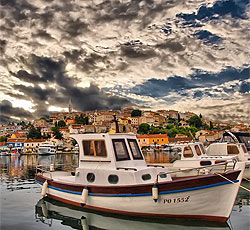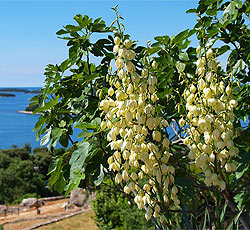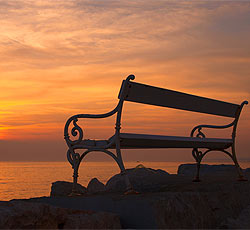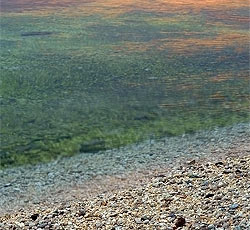-
Vrsar Archipelago (Vrsar, Istria)
It consists of 18 unpopulated green islands and islets, including: Figarolica, Lakal, Salamon, Zavata, Galiner, Sv. Juraj, Gusti skolj, Koversada i Orlandin. -
Giacomo Casanova Street (Vrsar, Istria)
The Italian adventurer and writer Giacomo Casanova stopped in Vrsar twice during the 18th century (in 1743 and 1749) and he wrote about it in his famous memoirs. According to the legend, Casanova did not just spend his summer holidays in Vrsar but took up residence there, so a Vrsar street containing La Casa di Rose, his alleged residence, was named after him. -
The Fkk Beach Koversada (Vrsar, Istria)
The Beach Koversada is situated under the same name camp and touristic settlement. It stretches 5 km along the coast with the various beaches. At the middle sandy beach the access for the people with special needs is arranged. One part of the beach is allowed for the dogs. Near the beach are few fun and recreational contents and is possible to rent deck chairs and umbrellas.
Fkk Beach Koversada Info -
The park of Dušan Dzamonja’s sculptures (Vrsar, Istria)
The protected house and Sculpture Park complex belonging to the greatest Croatian and European contemporary sculptor Dušan Džamonja, whose sculptures are exhibited in the most renowned museums of the world, is spread over an area in Vrsar which provides a view of one of the most beautiful archipelagos in the Mediterranean. The Sculpture Park has contained sculptures, graphics and drawings since 1970. -
Old Romanesque Gate (Vrsar, Istria)
The gate was built in the second half of the 17th century or the first half of the 18th century when the architecture and stone work in the towns of Istria turned to Romanesque style. The gate was included in the town wall system. It contains a fragment of the town walls and tablet with a shallow relief of St. Mark’s lion – a symbol of the Venetian rule.
Old Romanesque Gate Info
Vrsar, Útikalauz nyaraláshoz Vrsarban, Isztriában
Vrsar kultúrája
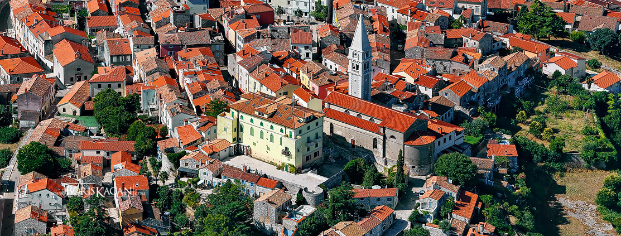
Az óváros keskeny boltíves utcái kis terekre, kőházakhoz, festői templomokhoz, a városkapuhoz és három városi kilátóhoz vezetnek. Vrsar partjának látványa elbűvölő: Isztria legöblösebb partszakaszát a legszebb mediterrán szigetcsoportok ékesítik. A kristálytiszta Adriai-tengerrel körülvett szigetek közül 18 lakatlan. Vrsar büszke lehet történelmére, mely az őskorig nyúlik vissza. Évszázadok óta ismerik forrásvízéről, ami nemcsak ókori nevét, az Ursaria-t (a régi mediterrán szó „ur" vagy „forrás”) magyarázza, de egy közeli hely, Funtana („forrás”) nevét is, ami szintén ideális célpont azoknak, akik pihenésre és felfrissülésre vágynak. Érdekesség, hogy az olasz költő és kalandor, Giacomo Casanova is a romantikus Vrsarban töltötte a nyarat 1743-ban és 1744-ben, és még híres emlékirataiban is megemlíti a helyet. A sótermelésnek köszönhetően Vrsar a világ régi térképeire is felkerült, és utcáin még abban a magas minőségű szürke kőben is gyönyörködhetünk, amit Velence építéséhez használtak fel a Római Birodalom idején. Vrsar a szobrászok városaként is ismert; itt található Dušan Džamonja híres szoborparkja. Kőszobrokkal pedig bárhol találkozhatunk a városban, melyek száma a Montraker nemzetközi szobrász iskola rendszeres látogatásai miatt egyre csak nő. A Vrsar körüli területen sok szőlő- és olajfaültetvény található, valamint gazdag kagylóban és egyéb tengeri finomságokban, melyeket a közeli Lim- csatorna Nemzeti Parkban termesztenek. Vrsar ezért az ínyencek és a borkedvelők egyik kedvenc célpontja. A turizmus fontos fogaskerék Vrsar gazdaságában, és a város több alkalommal is elnyerte a horvát Adria legjobb turistacélpontjának járó elismerést. Vrsar ideális üdülőhely azoknak, akik aktív kikapcsolódásra vágynak és azoknak is, akik családjukkal pihennének. Vrsar hatalmas kikötőjéről is ismert, ami Koversada, a legnagyobb naturista park közelében található.
